The Role of Web Analytics in Enhancing Student Outcomes in Education
VerifiedAdded on 2022/09/15
|5
|1078
|31
Essay
AI Summary
This essay delves into the application of web analytics within higher education, examining how institutions leverage data to enhance student success and institutional efficiency. It highlights the significance of predictive and prescriptive analytics as key tools for identifying patterns and making informed decisions. The essay outlines five specific ways web analytics is utilized, including targeting student scholarships, improving student admissions processes, identifying at-risk students, evaluating curriculum effectiveness, and optimizing fundraising efforts while also finding ways to save costs. The conclusion underscores the crucial role of big data and data analytics in understanding data relevance and reliability, ultimately contributing to better student outcomes.
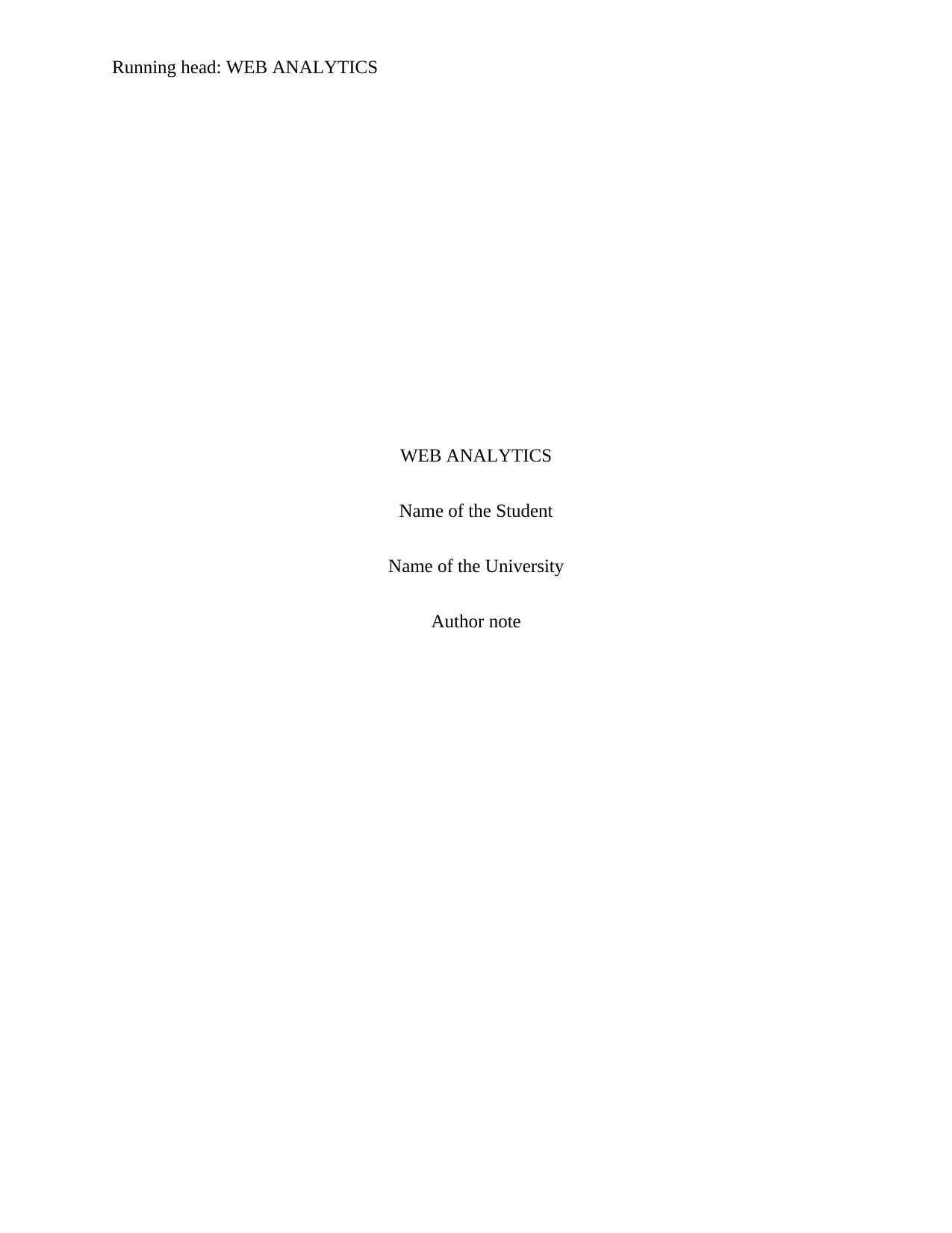
Running head: WEB ANALYTICS
WEB ANALYTICS
Name of the Student
Name of the University
Author note
WEB ANALYTICS
Name of the Student
Name of the University
Author note
Paraphrase This Document
Need a fresh take? Get an instant paraphrase of this document with our AI Paraphraser
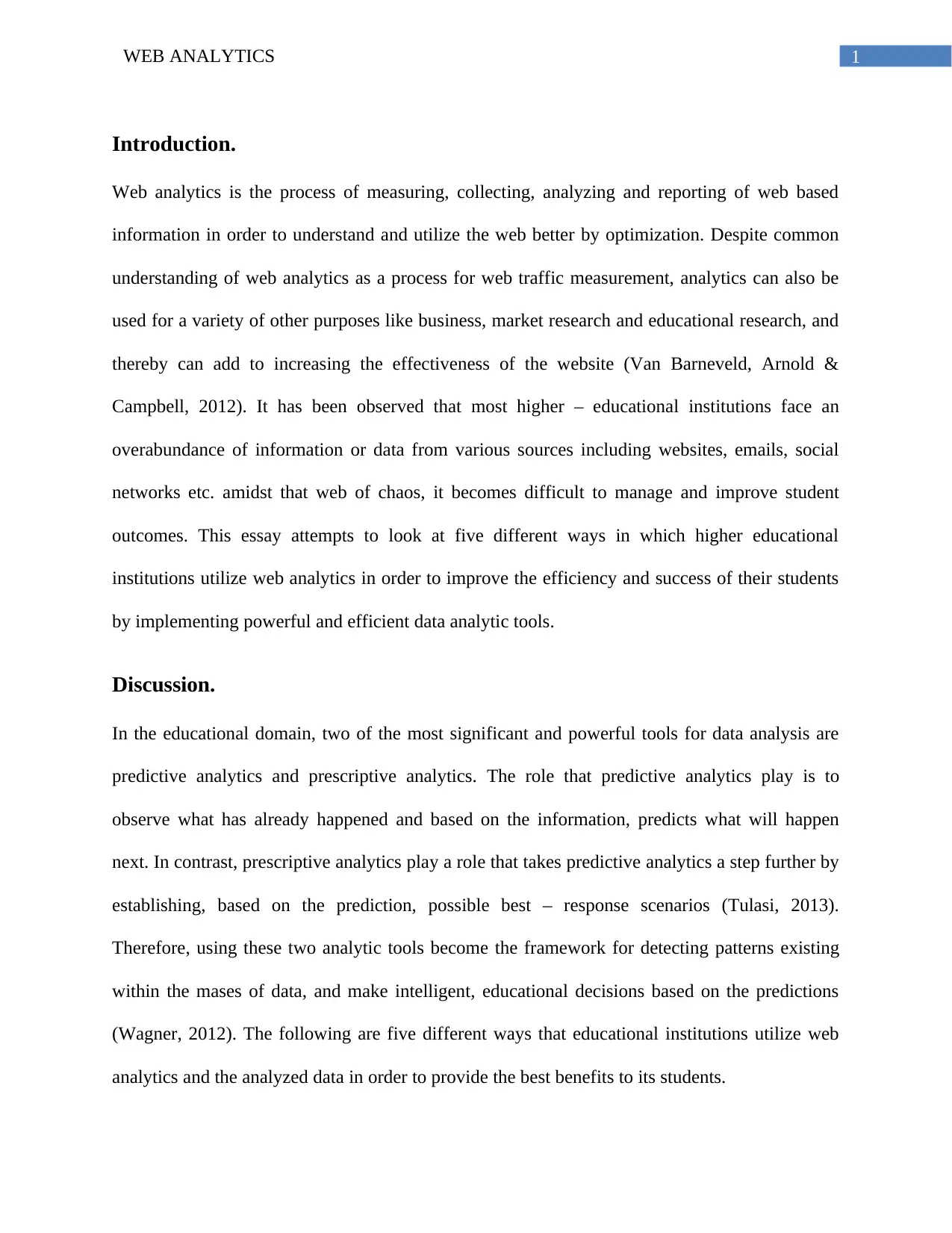
1WEB ANALYTICS
Introduction.
Web analytics is the process of measuring, collecting, analyzing and reporting of web based
information in order to understand and utilize the web better by optimization. Despite common
understanding of web analytics as a process for web traffic measurement, analytics can also be
used for a variety of other purposes like business, market research and educational research, and
thereby can add to increasing the effectiveness of the website (Van Barneveld, Arnold &
Campbell, 2012). It has been observed that most higher – educational institutions face an
overabundance of information or data from various sources including websites, emails, social
networks etc. amidst that web of chaos, it becomes difficult to manage and improve student
outcomes. This essay attempts to look at five different ways in which higher educational
institutions utilize web analytics in order to improve the efficiency and success of their students
by implementing powerful and efficient data analytic tools.
Discussion.
In the educational domain, two of the most significant and powerful tools for data analysis are
predictive analytics and prescriptive analytics. The role that predictive analytics play is to
observe what has already happened and based on the information, predicts what will happen
next. In contrast, prescriptive analytics play a role that takes predictive analytics a step further by
establishing, based on the prediction, possible best – response scenarios (Tulasi, 2013).
Therefore, using these two analytic tools become the framework for detecting patterns existing
within the mases of data, and make intelligent, educational decisions based on the predictions
(Wagner, 2012). The following are five different ways that educational institutions utilize web
analytics and the analyzed data in order to provide the best benefits to its students.
Introduction.
Web analytics is the process of measuring, collecting, analyzing and reporting of web based
information in order to understand and utilize the web better by optimization. Despite common
understanding of web analytics as a process for web traffic measurement, analytics can also be
used for a variety of other purposes like business, market research and educational research, and
thereby can add to increasing the effectiveness of the website (Van Barneveld, Arnold &
Campbell, 2012). It has been observed that most higher – educational institutions face an
overabundance of information or data from various sources including websites, emails, social
networks etc. amidst that web of chaos, it becomes difficult to manage and improve student
outcomes. This essay attempts to look at five different ways in which higher educational
institutions utilize web analytics in order to improve the efficiency and success of their students
by implementing powerful and efficient data analytic tools.
Discussion.
In the educational domain, two of the most significant and powerful tools for data analysis are
predictive analytics and prescriptive analytics. The role that predictive analytics play is to
observe what has already happened and based on the information, predicts what will happen
next. In contrast, prescriptive analytics play a role that takes predictive analytics a step further by
establishing, based on the prediction, possible best – response scenarios (Tulasi, 2013).
Therefore, using these two analytic tools become the framework for detecting patterns existing
within the mases of data, and make intelligent, educational decisions based on the predictions
(Wagner, 2012). The following are five different ways that educational institutions utilize web
analytics and the analyzed data in order to provide the best benefits to its students.
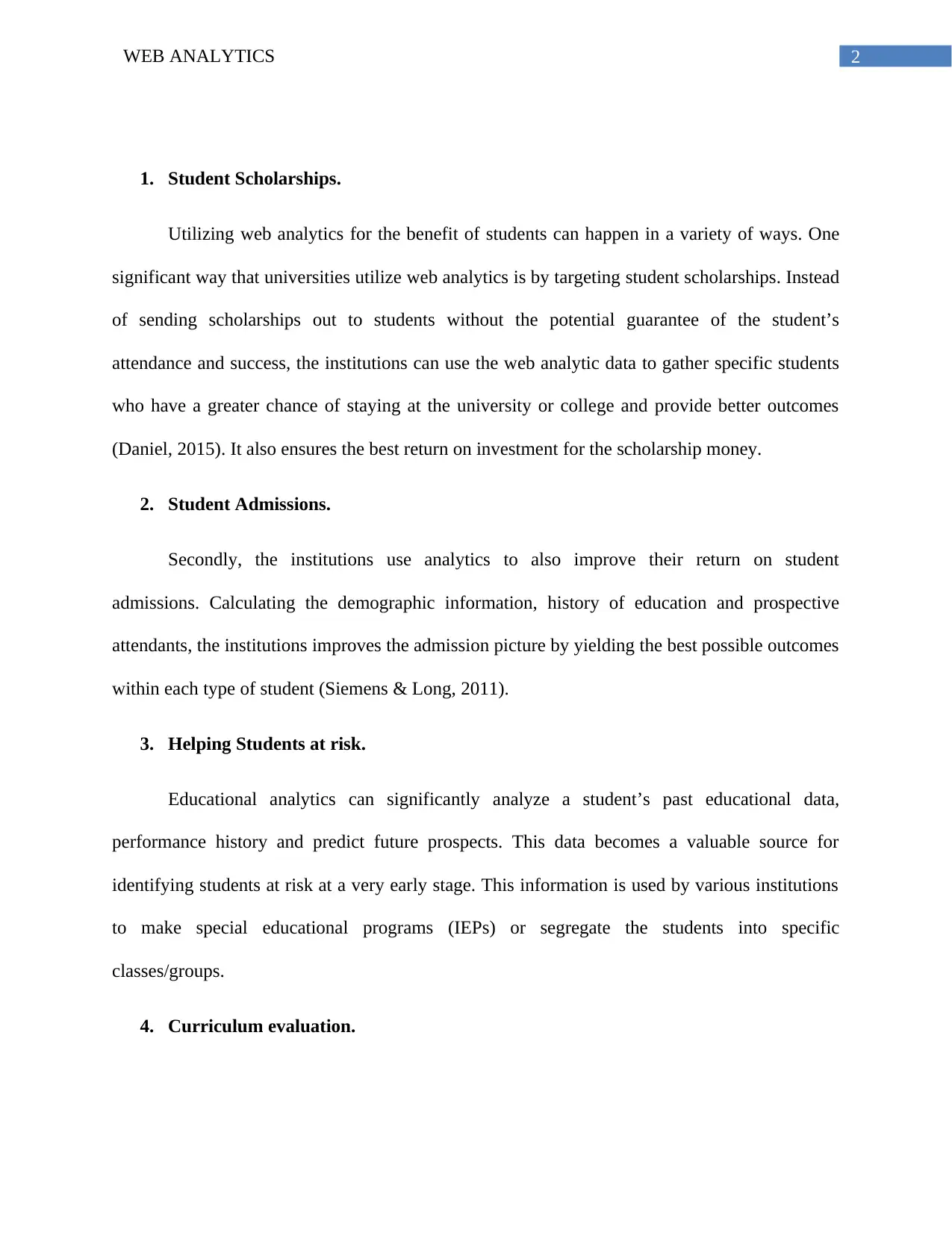
2WEB ANALYTICS
1. Student Scholarships.
Utilizing web analytics for the benefit of students can happen in a variety of ways. One
significant way that universities utilize web analytics is by targeting student scholarships. Instead
of sending scholarships out to students without the potential guarantee of the student’s
attendance and success, the institutions can use the web analytic data to gather specific students
who have a greater chance of staying at the university or college and provide better outcomes
(Daniel, 2015). It also ensures the best return on investment for the scholarship money.
2. Student Admissions.
Secondly, the institutions use analytics to also improve their return on student
admissions. Calculating the demographic information, history of education and prospective
attendants, the institutions improves the admission picture by yielding the best possible outcomes
within each type of student (Siemens & Long, 2011).
3. Helping Students at risk.
Educational analytics can significantly analyze a student’s past educational data,
performance history and predict future prospects. This data becomes a valuable source for
identifying students at risk at a very early stage. This information is used by various institutions
to make special educational programs (IEPs) or segregate the students into specific
classes/groups.
4. Curriculum evaluation.
1. Student Scholarships.
Utilizing web analytics for the benefit of students can happen in a variety of ways. One
significant way that universities utilize web analytics is by targeting student scholarships. Instead
of sending scholarships out to students without the potential guarantee of the student’s
attendance and success, the institutions can use the web analytic data to gather specific students
who have a greater chance of staying at the university or college and provide better outcomes
(Daniel, 2015). It also ensures the best return on investment for the scholarship money.
2. Student Admissions.
Secondly, the institutions use analytics to also improve their return on student
admissions. Calculating the demographic information, history of education and prospective
attendants, the institutions improves the admission picture by yielding the best possible outcomes
within each type of student (Siemens & Long, 2011).
3. Helping Students at risk.
Educational analytics can significantly analyze a student’s past educational data,
performance history and predict future prospects. This data becomes a valuable source for
identifying students at risk at a very early stage. This information is used by various institutions
to make special educational programs (IEPs) or segregate the students into specific
classes/groups.
4. Curriculum evaluation.
⊘ This is a preview!⊘
Do you want full access?
Subscribe today to unlock all pages.

Trusted by 1+ million students worldwide
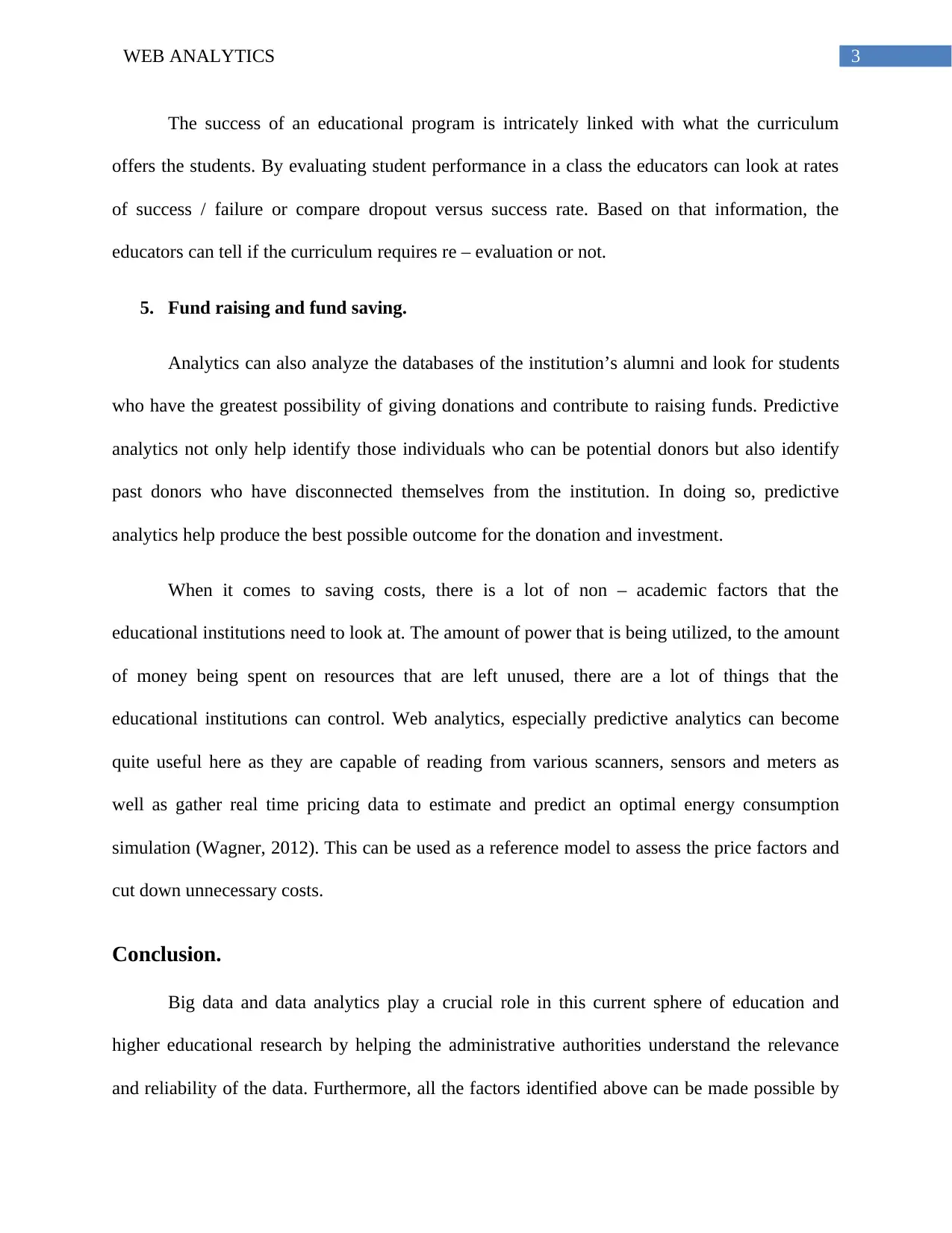
3WEB ANALYTICS
The success of an educational program is intricately linked with what the curriculum
offers the students. By evaluating student performance in a class the educators can look at rates
of success / failure or compare dropout versus success rate. Based on that information, the
educators can tell if the curriculum requires re – evaluation or not.
5. Fund raising and fund saving.
Analytics can also analyze the databases of the institution’s alumni and look for students
who have the greatest possibility of giving donations and contribute to raising funds. Predictive
analytics not only help identify those individuals who can be potential donors but also identify
past donors who have disconnected themselves from the institution. In doing so, predictive
analytics help produce the best possible outcome for the donation and investment.
When it comes to saving costs, there is a lot of non – academic factors that the
educational institutions need to look at. The amount of power that is being utilized, to the amount
of money being spent on resources that are left unused, there are a lot of things that the
educational institutions can control. Web analytics, especially predictive analytics can become
quite useful here as they are capable of reading from various scanners, sensors and meters as
well as gather real time pricing data to estimate and predict an optimal energy consumption
simulation (Wagner, 2012). This can be used as a reference model to assess the price factors and
cut down unnecessary costs.
Conclusion.
Big data and data analytics play a crucial role in this current sphere of education and
higher educational research by helping the administrative authorities understand the relevance
and reliability of the data. Furthermore, all the factors identified above can be made possible by
The success of an educational program is intricately linked with what the curriculum
offers the students. By evaluating student performance in a class the educators can look at rates
of success / failure or compare dropout versus success rate. Based on that information, the
educators can tell if the curriculum requires re – evaluation or not.
5. Fund raising and fund saving.
Analytics can also analyze the databases of the institution’s alumni and look for students
who have the greatest possibility of giving donations and contribute to raising funds. Predictive
analytics not only help identify those individuals who can be potential donors but also identify
past donors who have disconnected themselves from the institution. In doing so, predictive
analytics help produce the best possible outcome for the donation and investment.
When it comes to saving costs, there is a lot of non – academic factors that the
educational institutions need to look at. The amount of power that is being utilized, to the amount
of money being spent on resources that are left unused, there are a lot of things that the
educational institutions can control. Web analytics, especially predictive analytics can become
quite useful here as they are capable of reading from various scanners, sensors and meters as
well as gather real time pricing data to estimate and predict an optimal energy consumption
simulation (Wagner, 2012). This can be used as a reference model to assess the price factors and
cut down unnecessary costs.
Conclusion.
Big data and data analytics play a crucial role in this current sphere of education and
higher educational research by helping the administrative authorities understand the relevance
and reliability of the data. Furthermore, all the factors identified above can be made possible by
Paraphrase This Document
Need a fresh take? Get an instant paraphrase of this document with our AI Paraphraser
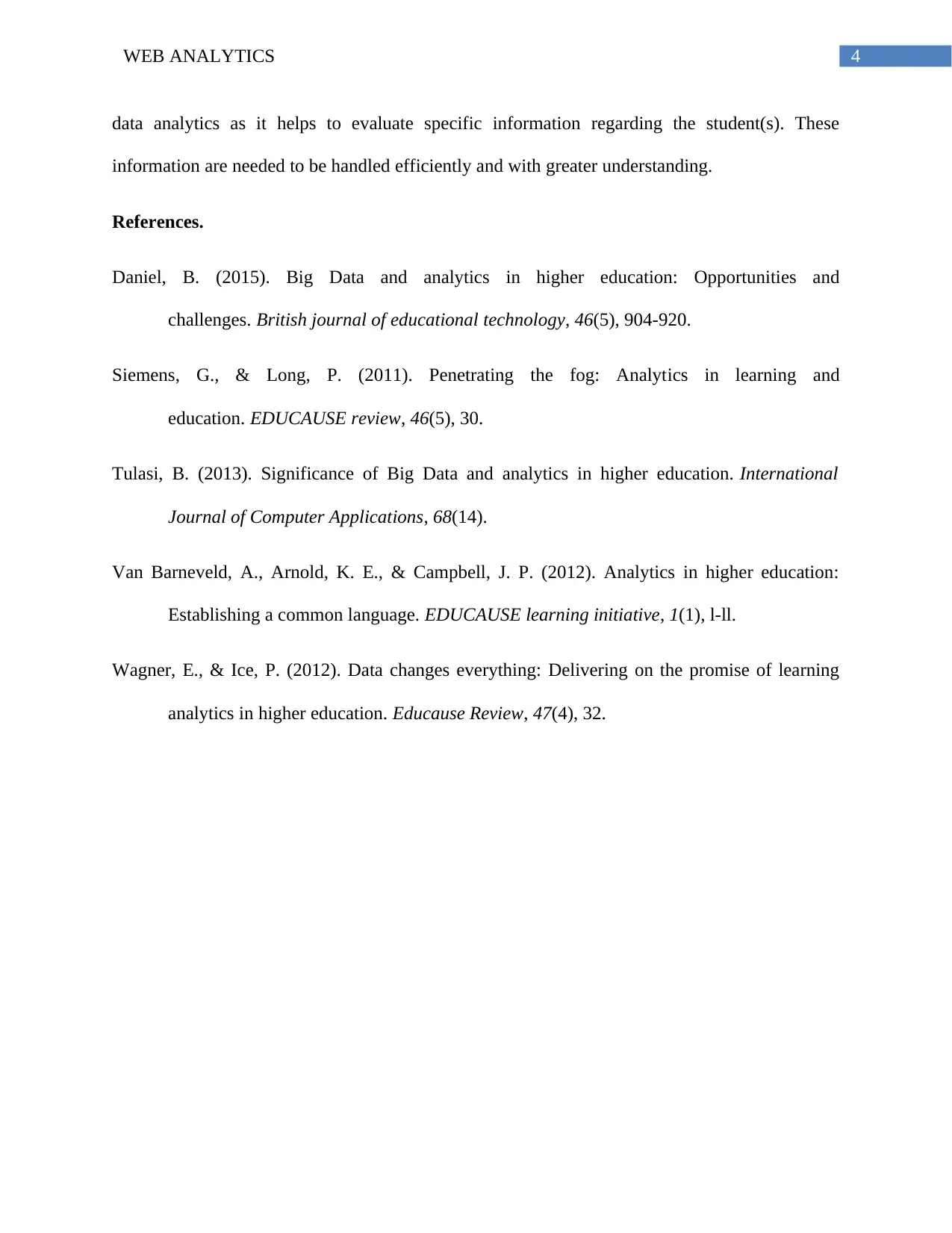
4WEB ANALYTICS
data analytics as it helps to evaluate specific information regarding the student(s). These
information are needed to be handled efficiently and with greater understanding.
References.
Daniel, B. (2015). Big Data and analytics in higher education: Opportunities and
challenges. British journal of educational technology, 46(5), 904-920.
Siemens, G., & Long, P. (2011). Penetrating the fog: Analytics in learning and
education. EDUCAUSE review, 46(5), 30.
Tulasi, B. (2013). Significance of Big Data and analytics in higher education. International
Journal of Computer Applications, 68(14).
Van Barneveld, A., Arnold, K. E., & Campbell, J. P. (2012). Analytics in higher education:
Establishing a common language. EDUCAUSE learning initiative, 1(1), l-ll.
Wagner, E., & Ice, P. (2012). Data changes everything: Delivering on the promise of learning
analytics in higher education. Educause Review, 47(4), 32.
data analytics as it helps to evaluate specific information regarding the student(s). These
information are needed to be handled efficiently and with greater understanding.
References.
Daniel, B. (2015). Big Data and analytics in higher education: Opportunities and
challenges. British journal of educational technology, 46(5), 904-920.
Siemens, G., & Long, P. (2011). Penetrating the fog: Analytics in learning and
education. EDUCAUSE review, 46(5), 30.
Tulasi, B. (2013). Significance of Big Data and analytics in higher education. International
Journal of Computer Applications, 68(14).
Van Barneveld, A., Arnold, K. E., & Campbell, J. P. (2012). Analytics in higher education:
Establishing a common language. EDUCAUSE learning initiative, 1(1), l-ll.
Wagner, E., & Ice, P. (2012). Data changes everything: Delivering on the promise of learning
analytics in higher education. Educause Review, 47(4), 32.
1 out of 5
Related Documents
Your All-in-One AI-Powered Toolkit for Academic Success.
+13062052269
info@desklib.com
Available 24*7 on WhatsApp / Email
![[object Object]](/_next/static/media/star-bottom.7253800d.svg)
Unlock your academic potential
Copyright © 2020–2025 A2Z Services. All Rights Reserved. Developed and managed by ZUCOL.




